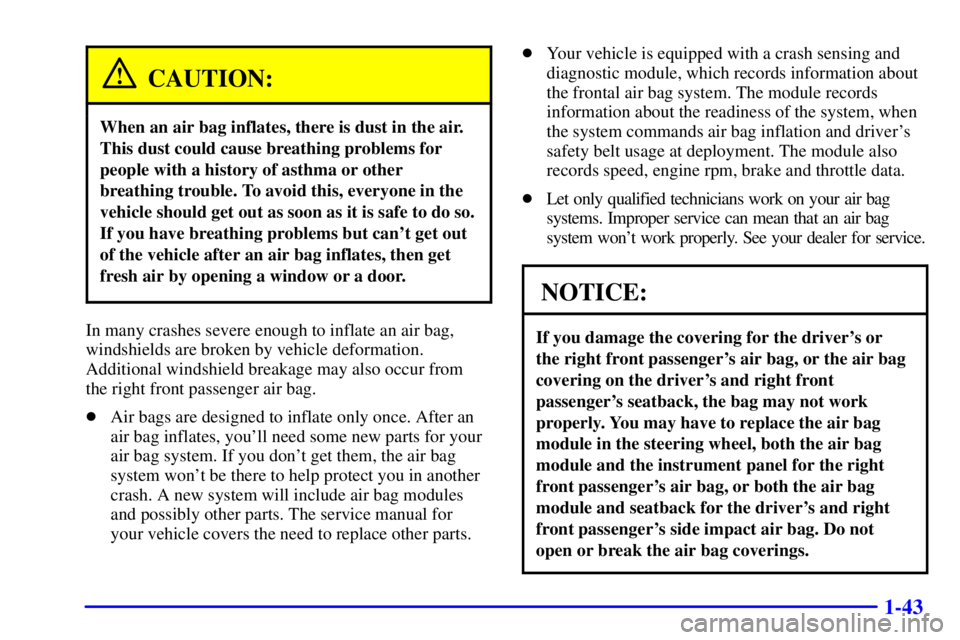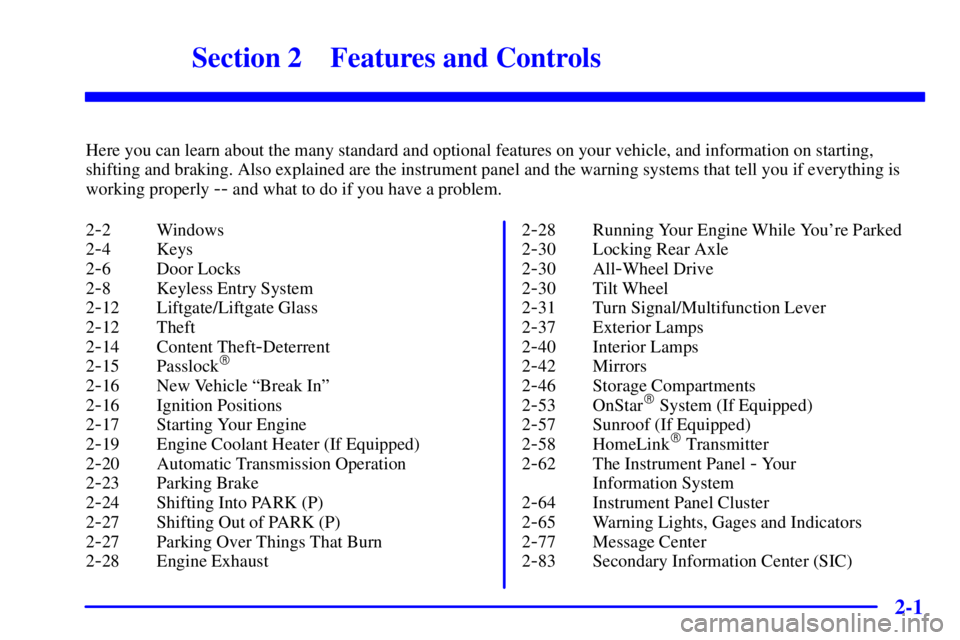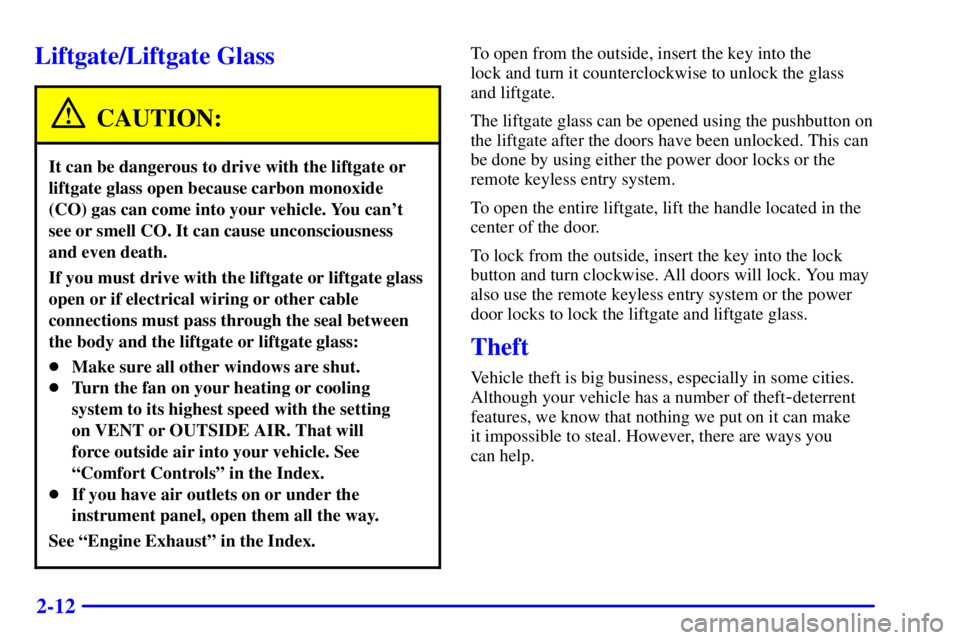Page 5 of 394
iii
Section
3
Comfort Controls and Audio Systems
Section
4
Your Driving and the Road
Section
5
Table of Contents (cont'd)
Your Driving, the Road and Your Vehicle
Defensive Driving
Drunken Driving
Control of a Vehicle
Braking
SteeringDriving Tips for Various Road Conditions
Off-Road Driving
Recreational Vehicle Towing
Loading Your Vehicle
Towing a Trailer Heating and Air Conditioning
Setting the Radio ClockRadio/Cassette Player/CD Player
Radio Theft-Deterrent Feature
Hazard Warning Flashers
Jump Starting
Towing Your VehicleEngine Overheating
Changing a Flat Tire
If You're Stuck
Problems on the Road
Page 6 of 394
iv
Fuel
Checking Fluids and Lubricants
GM Oil Life System™
Engine Air Cleaner/Filter
Passenger Compartment Air Filter
Brakes
Bulb ReplacementWindshield Wiper Blade Replacement
Tires and Wheels
Appearance Care
Electrical System/Fuses and Circuit Breakers
Capacities and Specifications
Normal Maintenance Replacement Parts
Table of Contents (cont'd)
Maintenance Schedule Service and Appearance Care
Section
7
Section
6
Scheduled Maintenance
Owner Checks and Services
Periodic Maintenance InspectionsRecommended Fluids and Lubricants
Maintenance Records
Page 11 of 394

ix
For example,
these symbols
are used on an
original battery:
CAUTION
POSSIBLE
INJURY
PROTECT
EYES BY
SHIELDING
CAUSTIC
BATTERY
ACID COULD
CAUSE
BURNS
AVOID
SPARKS OR
FLAMES
SPARK OR
FLAME
COULD
EXPLODE
BATTERY
These symbols
are important for
you and your
passengers
whenever your
vehicle is driven:
CHILD
RESTRAINT
TOP STRAP
ANCHOR
DOOR LOCK
UNLOCK
FASTEN
SEAT
BELTS
POWER
WINDOW
AIR BAG
These symbols
have to do with
your lamps:
MASTER
LIGHTING
SWITCH
TURN
SIGNALS
PARKING
LAMPS
HAZARD
WARNING
FLASHER
DAYTIME
RUNNING
LAMPS
FOG LAMPS
These symbols
are on some of
your controls:
WINDSHIELD
WIPER
WINDSHIELD
WASHER
WINDSHIELD
DEFROSTER
REAR
WINDOW
DEFOGGER
VENTILATING
FAN
These symbols
are used on
warning and
indicator lights:
ENGINE
COOLANT
TEMP
BATTERY
CHARGING
SYSTEM
BRAKE
COOLANT
ENGINE OIL
PRESSURE
ANTI-LOCK
BRAKES
Here are some
other symbols
you may see:
FUSE
LIGHTER
HORN
FUEL
Vehicle Symbols
These are some of the symbols you may find on your vehicle. Also see ªWarning Lights and Gagesº in the Index.
Page 13 of 394
For
a More
Detailed Look at
What's Under the Hood
See Section 6
Service Station Guide
Cooling System
See Section 5
Spare Tire Pressure
See Section 6
Tire Pressure
See Section 6
Fuel
Use unleaded only.
See Section 6
for octane ratings.
Oil Viscosity
Engine Oil
See Section 6
Engine Oil Dipstick
See Section 6
Hood Release
See Section 6
Windshield Washer
Fluid
See Section 6Battery
See Section 6
Page 56 of 394

1-43
CAUTION:
When an air bag inflates, there is dust in the air.
This dust could cause breathing problems for
people with a history of asthma or other
breathing trouble. To avoid this, everyone in the
vehicle should get out as soon as it is safe to do so.
If you have breathing problems but can't get out
of the vehicle after an air bag inflates, then get
fresh air by opening a window or a door.
In many crashes severe enough to inflate an air bag,
windshields are broken by vehicle deformation.
Additional windshield breakage may also occur from
the right front passenger air bag.
�Air bags are designed to inflate only once. After an
air bag inflates, you'll need some new parts for your
air bag system. If you don't get them, the air bag
system won't be there to help protect you in another
crash. A new system will include air bag modules
and possibly other parts. The service manual for
your vehicle covers the need to replace other parts.�Your vehicle is equipped with a crash sensing and
diagnostic module, which records information about
the frontal air bag system. The module records
information about the readiness of the system, when
the system commands air bag inflation and driver's
safety belt usage at deployment. The module also
records speed, engine rpm, brake and throttle data.
�Let only qualified technicians work on your air bag
systems. Improper service can mean that an air bag
system won't work properly. See your dealer for service.
NOTICE:
If you damage the covering for the driver's or
the right front passenger's air bag, or the air bag
covering on the driver's and right front
passenger's seatback, the bag may not work
properly. You may have to replace the air bag
module in the steering wheel, both the air bag
module and the instrument panel for the right
front passenger's air bag, or both the air bag
module and seatback for the driver's and right
front passenger's side impact air bag. Do not
open or break the air bag coverings.
Page 88 of 394

2-
2-1
Section 2 Features and Controls
Here you can learn about the many standard and optional features on your vehicle, and information on starting,
shifting and braking. Also explained are the instrument panel and the warning systems that tell you if everything is
working properly
-- and what to do if you have a problem.
2
-2 Windows
2
-4 Keys
2
-6 Door Locks
2
-8 Keyless Entry System
2
-12 Liftgate/Liftgate Glass
2
-12 Theft
2
-14 Content Theft-Deterrent
2
-15 Passlock�
2-16 New Vehicle ªBreak Inº
2
-16 Ignition Positions
2
-17 Starting Your Engine
2
-19 Engine Coolant Heater (If Equipped)
2
-20 Automatic Transmission Operation
2
-23 Parking Brake
2
-24 Shifting Into PARK (P)
2
-27 Shifting Out of PARK (P)
2
-27 Parking Over Things That Burn
2
-28 Engine Exhaust2
-28 Running Your Engine While You're Parked
2
-30 Locking Rear Axle
2
-30 All-Wheel Drive
2
-30 Tilt Wheel
2
-31 Turn Signal/Multifunction Lever
2
-37 Exterior Lamps
2
-40 Interior Lamps
2
-42 Mirrors
2
-46 Storage Compartments
2
-53 OnStar� System (If Equipped)
2
-57 Sunroof (If Equipped)
2
-58 HomeLink� Transmitter
2
-62 The Instrument Panel - Your
Information System
2
-64 Instrument Panel Cluster
2
-65 Warning Lights, Gages and Indicators
2
-77 Message Center
2
-83 Secondary Information Center (SIC)
Page 99 of 394

2-12
Liftgate/Liftgate Glass
CAUTION:
It can be dangerous to drive with the liftgate or
liftgate glass open because carbon monoxide
(CO) gas can come into your vehicle. You can't
see or smell CO. It can cause unconsciousness
and even death.
If you must drive with the liftgate or liftgate glass
open or if electrical wiring or other cable
connections must pass through the seal between
the body and the liftgate or liftgate glass:
�Make sure all other windows are shut.
�Turn the fan on your heating or cooling
system to its highest speed with the setting
on VENT or OUTSIDE AIR. That will
force outside air into your vehicle. See
ªComfort Controlsº in the Index.
�If you have air outlets on or under the
instrument panel, open them all the way.
See ªEngine Exhaustº in the Index.
To open from the outside, insert the key into the
lock and turn it counterclockwise to unlock the glass
and liftgate.
The liftgate glass can be opened using the pushbutton on
the liftgate after the doors have been unlocked. This can
be done by using either the power door locks or the
remote keyless entry system.
To open the entire liftgate, lift the handle located in the
center of the door.
To lock from the outside, insert the key into the lock
button and turn clockwise. All doors will lock. You may
also use the remote keyless entry system or the power
door locks to lock the liftgate and liftgate glass.
Theft
Vehicle theft is big business, especially in some cities.
Although your vehicle has a number of theft
-deterrent
features, we know that nothing we put on it can make
it impossible to steal. However, there are ways you
can help.
Page 102 of 394

2-15 Testing the Alarm
The alarm can be tested by following these steps:
1. From inside the vehicle, lower the driver's window
and open the driver's door.
2. Activate the system by locking the doors with the
power door lock switch while the door is open, or
with the remote keyless entry transmitter.
3. Get out of the vehicle, close the door and wait for the
SECURITY message to go out.
4. Then reach in through the window, unlock the door
with the manual door lock and open the door. This
should set off the alarm.
If the alarm does not sound when it should but the
headlamps flash, check to see if the horn works. The
horn fuse may be blown. To replace the fuse, see ªFuses
and Circuit Breakersº in the Index.
If the alarm does not sound or the headlamps do not
flash, the vehicle should be serviced by an authorized
service center.
Passlock�
Your vehicle is equipped with the Passlock
theft
-deterrent system.
Passlock is a passive theft
-deterrent system. Passlock
enables fuel if the ignition lock cylinder is turned with a
valid key. If a correct key is not used or the ignition lock
cylinder is tampered with, fuel is disabled.
If the engine stalls and the SECURITY message flashes,
wait until the message stops flashing before trying to
restart the engine. Remember to release the key from
START as soon as the engine starts.
If the engine is running and the SECURITY message
comes on, you will be able to restart the engine if you
turn the engine off. However, your Passlock system is
not working properly and must be serviced by your
dealer. Your vehicle is not protected by Passlock at this
time. You may also want to check the fuse (see ªFuses
and Circuit Breakersº in the Index). See your dealer
for service.
In an emergency, call the GMC Roadside Assistance
Center. See ªRoadside Assistanceº in the Index.